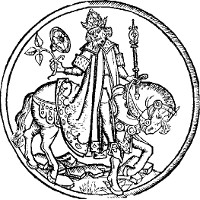Playing cards of monogrammist PW
, c. 1500
In the late fifteenth or possibly very early sixteenth century, a
Colognian master known only by the signature PW
created a unique
deck of five-suited circular copperplate-engraved playing cards. As in
several other early luxury decks, each suit contains 14 cards—besides a
full set of pip cards from 1 to 10, a queen supplements the conventional
German court cards Unter, Ober and
king. With five such suits and two additional cards with unknown
functions, the total number of cards end up at an impressive 72.
The five suits are parrots, hares, carnations, columbines and roses. In the court cards, the suit symbols do not relate to the court figures or the background scenery, but are simply placed in the largest otherwise empty part of the designs. The only exception to this is the Unter of hares, where the hare indicating the suit sits on a hill in the background.
While imprints of all cards survive, no single collection holds a complete set. The collection closest to achieving this is Pinacoteca Nazionale di Bologna, which with 69 cards lacks only three. These are uncoloured, and in several cards the enclosing double circle is wholly or partially cut away. Second is the Kupferstich-Kabinett in Dresden, which has a very deliberate selection. Through the removal of the entire suit of carnations and the Unter rank, the deck is reduced to a standard 52 card deck with French courts. Apart from this, only the eight of hares is missing; while one of the two extra cards is retained. The majority of the cards are at least partially coloured, and each card is defaced with a stamp.
Modern replica
The 1974 replica by Edition Leipzig/Heimeran Verlag is based on the Dresden Kupferstich-Kabinett collection. The missing title card, Unter cards and the suit of carnations is primarily supplied from the Pinacoteca Nazionale di Bologna collection. While the accompanying book omits mentioning it, this must also be the case for the eight of hares. The two exceptions are the coloured Unter of hares from the British Museum and the five of carnations from the Graphische Sammlung Albertina in Vienna.
| Title card | Memento mori card | |||
|---|---|---|---|---|
 |
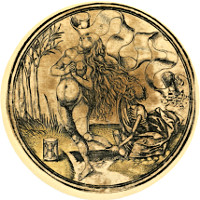 |
|||
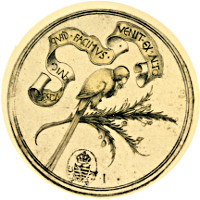 |
 |
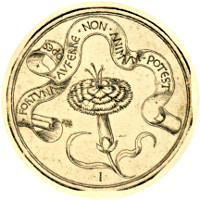 |
 |
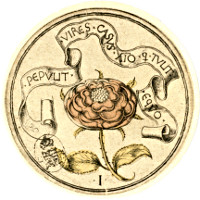 |
 |
 |
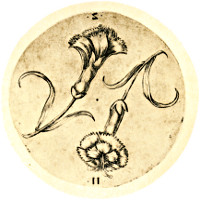 |
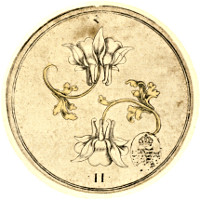 |
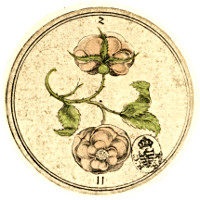 |
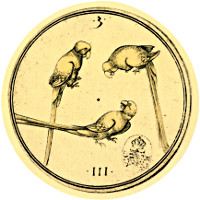 |
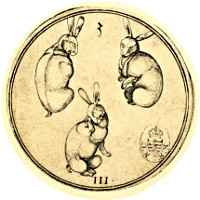 |
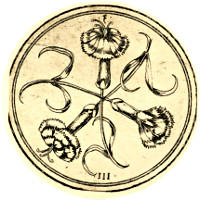 |
 |
 |
 |
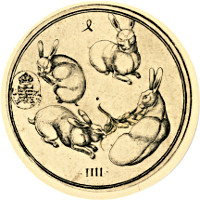 |
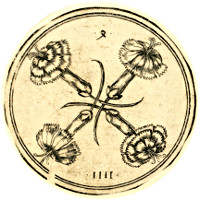 |
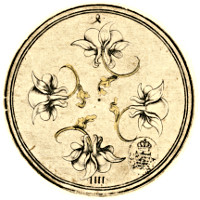 |
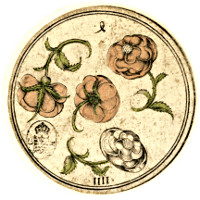 |
 |
 |
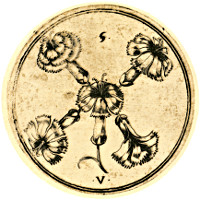 |
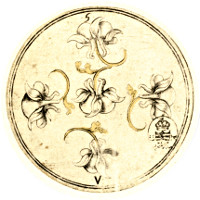 |
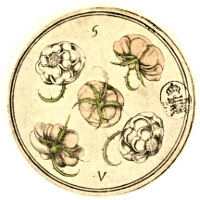 |
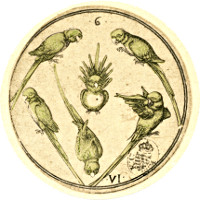 |
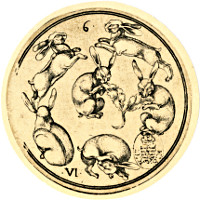 |
 |
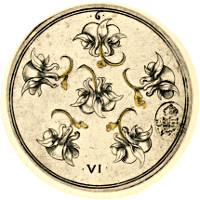 |
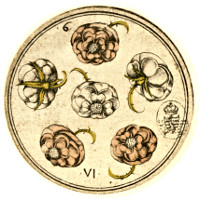 |
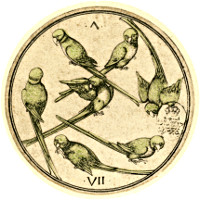 |
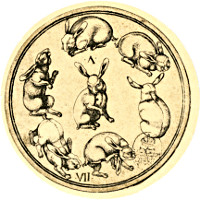 |
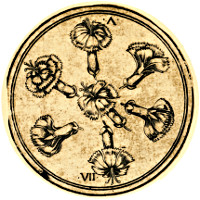 |
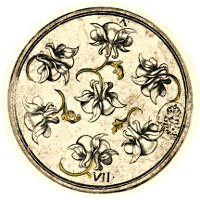 |
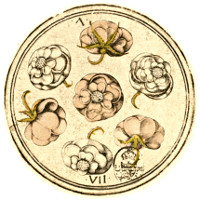 |
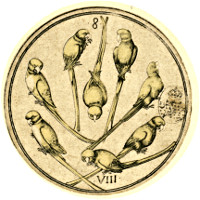 |
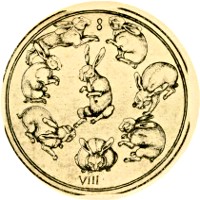 |
 |
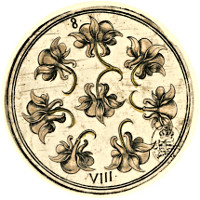 |
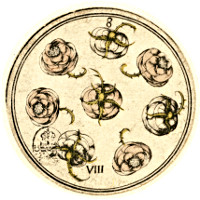 |
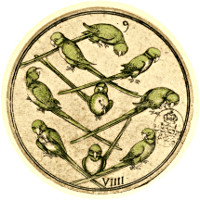 |
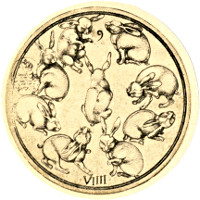 |
 |
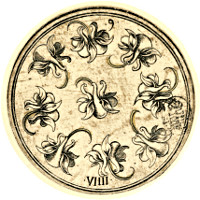 |
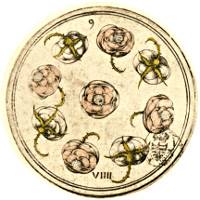 |
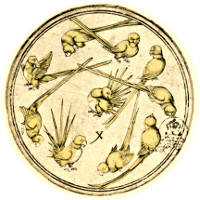 |
 |
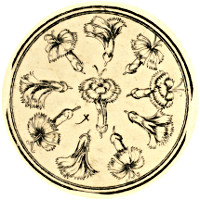 |
 |
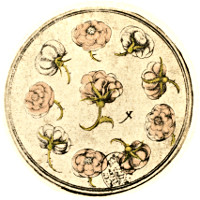 |
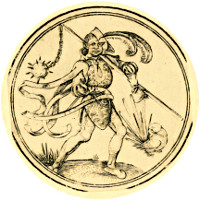 |
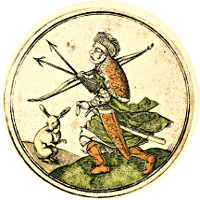 |
 |
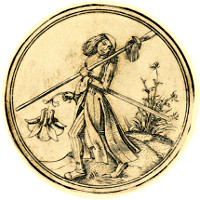 |
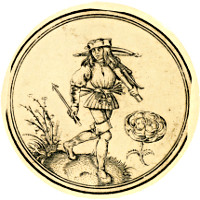 |
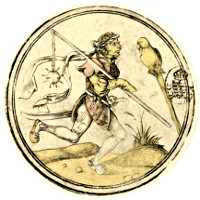 |
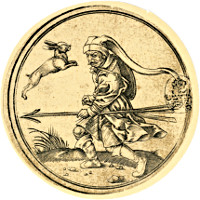 |
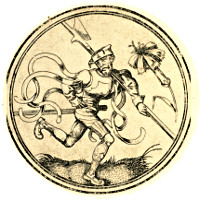 |
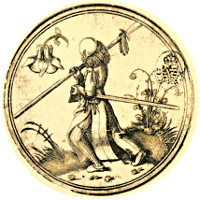 |
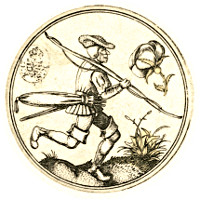 |
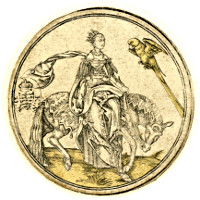 |
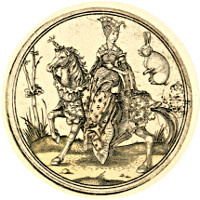 |
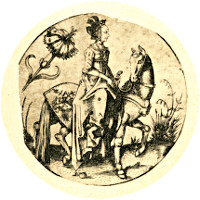 |
 |
 |
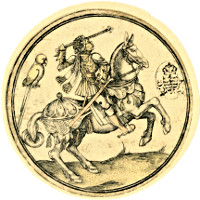 |
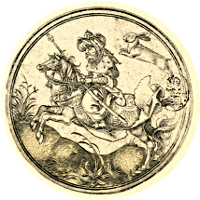 |
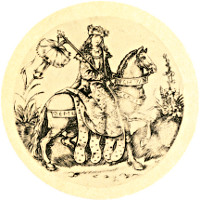 |
 |
 |
| Parrots (Moors) |
Hares (Turks) |
Carnations (Germans) |
Columbines (Spaniards) |
Roses (Englishmen) |
In three of the suits, all four court cards are walking or riding to
the right, while in hares and columbines, they are moving leftwards.
This is neither coincidental nor done for purely aestethic purposes, but
rather indicates that the latter two suits were weak
; meaning
that the pip cards were ranked backwards with 10 as the lowest and 1 as
the highest card – a common feature in old playing cards. For each suit,
the persons on the court cards belong to a particular nationality or
ethnicity, shown by facial characteristics, costumes and weaponry.
Parrots courts are clearly Moors. Both Unter and Ober carry long-handled flails with short chains and spiked balls, as well as sheathed curved scimitars. The king brandishes a sceptre like all other kings, and has a sheathed straight sword. He has spurs on his boots and wears a twisted cloth headband. Unlike the headgear of the other kings, this does not signify rank, as the Unter wears an identical one.
Hare courts are equally clearly Turks. The Unter carries a bow and arrows, while the Ober has a broad-headed fletched javelin. Both of them, as well as the king, have very slightly curved sheathed scimitars. The king wears an elaborate turban.
The remaining three groups are all European, and therefore more similar to each other. All but one of the Unters and Obers carry straight sheathed swords, while all three kings are unarmed and wear a circelet crowns. This similarity makes it more difficult to attribute a nationality to each than to identify the two non-European ones.
However, it is fairly certain that carnations represent Germans.
Here, the Unter and Ober both carry
halberds. Three scrolls with text adorn his horse; two of them reads Ich wägerte
, older German for I improved
. This text
coupled with the halberds' popularity among German Landsknechts are the main reasons for assuming that this
suit represents Germans.
Columbines is perhaps the suit that is hardest to assign a nationality to. Spanish seems most probable, but Portuguese is not out of the question either. The Unter and Ober carry spears, and the queen rides a donkey rather than a horse.
Finally, roses is probably Englishmen – the rose was at this time already well established as a heralic emblem of the Englich crown. The Unter carries a crossbow, and is the only Unter or Ober without a sword. The Ober the longbow that the English were famous for. The queen has a hunting falcon on her left hand; all other queens are empty handed.
The pip cards from 2 to 9 have Arabic numerals at the top and Roman ones at the bottom of the card. In the suit of carnations, the Arabic figures 2 and 3 are mirrored; this might indicate that this was the first suit to be engraved. The tens have Roman numerals only, placed below or to the right of the central suit sign. There is otherwise no special treatment of the tens, they simply have the suit symbol repeated ten times. The ones (aces) have numerals only at the bottom, presumably Roman, though Roman and Arabic are indistinguishable in this case. Here the tops of the cards are covered by long scrolls bearing Latin mottoes.
Both the two extra cards have scrolls similar to the ones on the
aces. One of them, the Title card
, has a symmetrical design with
three short scrolls each with a single word of the Latin phrase Salve felix Colonia Hail, happy Cologne
. The
other one curiously has a long scroll with no text at all, placed above
a Memento mori scene.
Other collections
The British Museum in London has a somewhat more modest 39 cards, two of which are partially coloured. However, they have published scans of every card in their collection online; thumbnails of these can be seen below. For consistency, I have converted these to grayscale (except for the two partially coloured cards), but each link to the original British Museum web page containing the colour image.
| Title card | ||||
|---|---|---|---|---|
| Parrots | Hares | Carnations | Columbines | Roses |
Eight cards from the Musée du Louvre in Paris, and a single card in the Victoria and Albert Museum in London.
Copy by Telman von Wesel, c. 1500
Though hardly a success as actual playing cards—for which they are entirely impractical—they were famous enough to be copied or imitated at least three times. First by Telman von Wesel, who seems to have been working from a deliberately shortened set similar to the one in Dresden, only with the suit of roses rather than carnations removed. These cards are fairly well copied, though reversed and with minor alterations made to a few cards. The missing Unter rank on the other hand is filled in with entirely new designs, which do not follow the facing convention that the originals adhere to.
Works by Telman von Wesel are dated from 1490 to 1510; the British Museum dates his cards to between 1499 and 1510.
 |
 |
 |
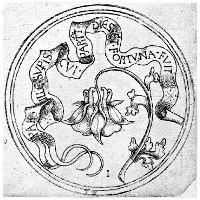 |
 |
|||
 |
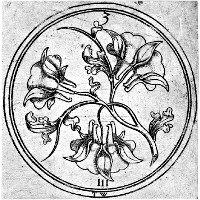 |
||
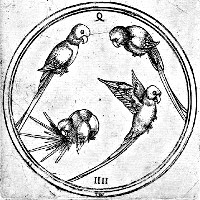 |
 |
 |
|
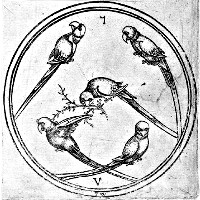 |
 |
||
 |
 |
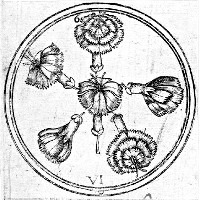 |
 |
 |
 |
 |
|
 |
 |
 |
 |
 |
 |
 |
 |
 |
 |
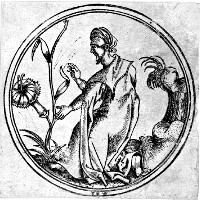 |
 |
 |
 |
||
 |
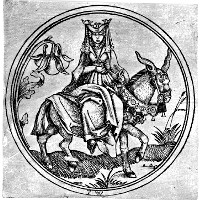 |
||
 |
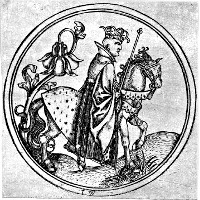 |
Reworking by Johann Bussemacher, 1591
This deck adapts the designs into a more conventional rectangular format. Again one suit and one rank of court cards are removed. As in the Telman von Wesel cards, the dropped suit is roses, but in difference to this and the Dresden set, it is the Ober rank that is removed. Unlike the former but like the latter, the result is a 52 card deck with a structure identical to French decks: 1–10, knave, queen and king.
The knave designs are somewat mixed up with regards to suits. The knave of parrots is based on the Unter of columbines, the knave of hares on the Unter of roses, the knave of carnations on the Unter of parrots and the knave of columbines on the Unter of carnations. The features that are preserved are their weapons and their general posture; the indications of various nationalities are on the other hand not kept. The three originally right-facing ones are reversed, so that all end up left-facing. Note that one of the knaves in Johann Bussemachers deck is based on the design from the suit that is not used in this deck. This suggests that unlike Telman von Wesel, he had a full deck as his source, and performed the shortening himself.
The queens and kings diverge even more from the source than the knaves do, but they are still all mounted, and some designs are based on cards from the PW deck. The queens of hares and carnations both ride donkeys like the original queen of columbines. The queen of parrots is reminiscent of the original queens of hares and roses. The kings of parrots and hares are similar to reversed versions of the original kings of carnations and columbines respectively. The king of carnations is based on a reversed original king of parrots, but is given metal armor, including a face-covering helmet. The queen and king of columbines are not based on any original cards, but instead depict a nun and a monk.
PW-inspired cards by Virgil Solis, 1544
These cards are neither copies nor adaptations of the PW deck, but
clearly and strongly inspired by them. The rectangular engraved cards
have four suits; lions, parrots, peacocks and monkeys. Even the single
matching suit has entirely independent designs. The pip cards include
the full 1–10 range. Instead of the original's Unter
and Ober ranks, Solis' cards only have a single
knave
rank. The court cards retain the at this time unusual
feature of having mounted kings and queens, but not their specific
designs. Despite having redesigned court cards with more modern
costumes, they retain the convention of having the courts in the
weak
suits facing to the left and the strong
ones to the
right. As the designs are independent, it is impossible to tell whether
or not he had access to a complete set, or like Telman von Wesel an
already shortened one.
Evidence for a French type deck structure in the German area
Based on this extravagant 70 card deck (disregarding the two
extra
cards) firmly placed in the German tradition, we have
evidence for no fewer than four or five independent instances where it was
adapted to the 52 card structure of French type cards made or preserved
within the area dominated by German type cards:
- The almost contemporary copy by Telman von Wesel
- The 1544 cards by Virgil Solis (in Nuremberg)
- The 1591 reworking by Johann Bussemacher (in Cologne)
- The Dresden Kupferstich-Kabinett set
- The Louvre set, with kings, queens and one Ober, but no Unter cards (possibly due to chance)
The first three were consciously restructured already in the sixteenth century, one of them in the very beginning; the fourth probably so as well. As it is unlikely that this should happen by chance at four different times and places, it seems more likely that the workshop that produced the cards made both full and shortened sets.
The Flemish hunting deck, dated to c. 1475 is presumably the oldest deck known to have this structure.
Other prints with possible relations
There exists a single woodcut with an unclear relation to the
engraved cards. It is not known to form part of a deck of cards, but has
enough similarities to the king of roses that it might be based on this.
Both designs are circular, featuring a bearded man on horseback carrying
a scepter and wearing a crown and luxurious clothes. In the card, the
suit symbol of a rose floats
behind the king, while in the
woodcut, he holds it in his left hand. Besides being reversed, as is
also common in true copies, there are a multitude of differences
